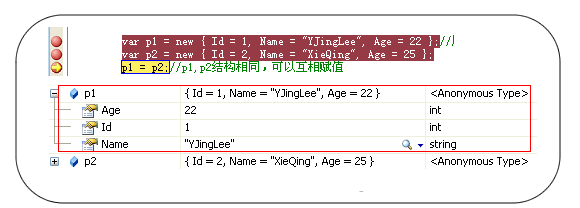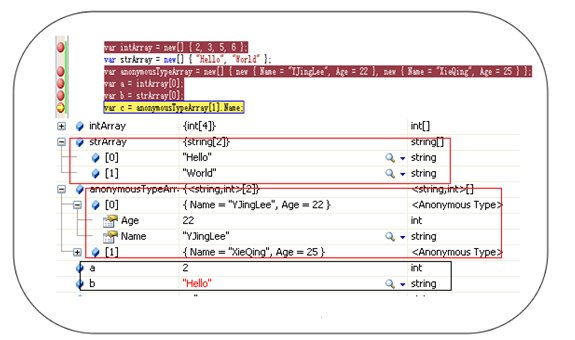/// <summary>
/// CollectionInitializers(集合初始化器)的摘要说明
/// </summary>
public class CollectionInitializers
{
public int ID { get; set; }
public string Name { get; set; }
public void CollectionInitializersTest()
{
List<CollectionInitializers> list = new List<CollectionInitializers>
{
new CollectionInitializers { ID = 1, Name = "webabcd" },
new CollectionInitializers { ID = 2, Name = "webabcdefg" },
new CollectionInitializers { ID = 3, Name = "webabcdefghijklmn" }
};
// 上面的list集合(集合初始化器)等同于下面的list集合
// List<CollectionInitializers> list = new List<CollectionInitializers>();
// list.Add(new CollectionInitializers { ID = 1, Name = "webabcd" });
// list.Add(new CollectionInitializers { ID = 2, Name = "webabcdefg" });
// list.Add(new CollectionInitializers { ID = 3, Name = "webabcdefghijklmn" });
}
}
匿名类型允许定义行内类型,无须显式定义类型。常和var配合使用来声明匿名类型。
var p1 = new { Id = 1, Name = "YJingLee", Age = 22 };//属性也不需要申明 var p2 = new { Id = 2, Name = "XieQing", Age = 25 }; p1 = p2;//p1,p2结构相同,可以互相赋值
在这里编译器会认为p1,p2相当于:
public class SomeType { public int Id { get; set; } public string Name { get; set; } public int Age { get; set; } }
那么数组怎么定义呢?使用"new[]"关键字来声明数组,加上数组的初始值列表。像这样:
var intArray = new[] { 2, 3, 5, 6 }; var strArray = new[] { "Hello", "World" }; var anonymousTypeArray = new[] { new { Name = "YJingLee", Age = 22 }, new { Name = "XieQing", Age = 25 } }; var a = intArray[0]; var b = strArray[0]; var c = anonymousTypeArray[1].Name;
匿名类型要点
- 可以使用new关键字调用匿名初始化器创建一个匿名类型的对象。
- 匿名类型直接继承自System. Object。
- 匿名类型的成员是编译器根据初始化器推断而来的一些读写属性。

